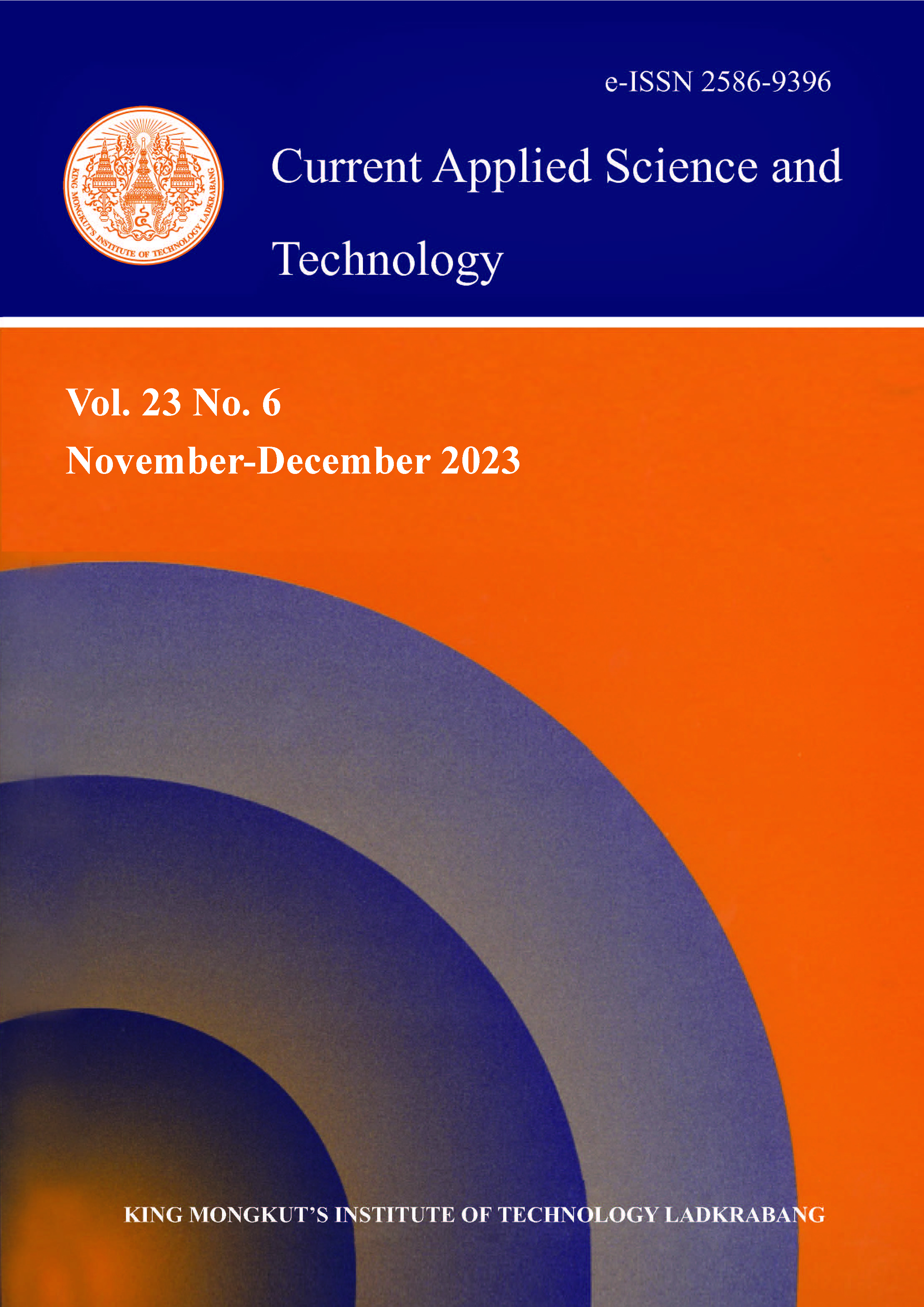The Effect of Annealing Treatment on WO3 Thin Film Prepared by Reactive DC Magnetron Sputtering for Photo-electrochemical Water Splitting Application
Main Article Content
Abstract
In this work, WO3 thin films were fabricated by reactive DC magnetron sputtering, and then thermally annealed at 400°C for 2 h under air, low vacuum and high vacuum. After the annealing treatments, the morphology and crystallinity of the WO3 thin films were observed using FE-SEM, GI-XRD and Raman spectroscopy. The optical properties were analyzed by UV-Vis spectroscopy. The results showed the decrease of film thickness under different annealing conditions. In addition, the annealing conditions also affected the crystalline structure at diffraction planes (200) and (002). The transmittance of the WO3 thin films revealed that the annealing treatment at high vacuum led to lower transparency. Furthermore, the WO3 thin film annealed under air produced the highest PEC efficiency. Therefore, this approach offers an alternative strategy for photoelectrochemical (PEC) water splitting application.
Keywords: WO3 thin film; DC magnetron sputtering; photoelectrochemical water splitting
*Corresponding author: Tel.: (+66) 25646900 Ext.2700
E-mail: saksorn.limwichean@nectec.or.th
Article Details

This work is licensed under a Creative Commons Attribution-NonCommercial-NoDerivatives 4.0 International License.
Copyright Transfer Statement
The copyright of this article is transferred to Current Applied Science and Technology journal with effect if and when the article is accepted for publication. The copyright transfer covers the exclusive right to reproduce and distribute the article, including reprints, translations, photographic reproductions, electronic form (offline, online) or any other reproductions of similar nature.
The author warrants that this contribution is original and that he/she has full power to make this grant. The author signs for and accepts responsibility for releasing this material on behalf of any and all co-authors.
Here is the link for download: Copyright transfer form.pdf
References
Wang, J., Ree, T., Wu, Y., Zhang, P. and Gao, L., 2018. Metal oxide semiconductors for solar water splitting. In: J.C. Védrine, ed. Metal Oxides in Energy Technologies. Amsterdam: Elsevier, pp.205-249.
Zong, X. and Li, C., 2018. Photocatalytic water splitting on metal oxide-based semiconductor photocatalysts. In: J.C. Védrine, ed. Metal Oxides in Heterogeneous Catalysis. Amsterdam: Elsevier, pp. 355-399.
Zheng, H., Ou, J., Strano, M.S., Kaner, R.B., Mitchell, A. and Kalantar-zadeh, K., 2011. Nanostructured Tungsten Oxide – Properties, Synthesis, and Applications. Advanced Functional Materials, 21(12), 2175-2196, DOI: 10.1002/adfm.201002477.
Liu, X., Wang, F. and Wang, Q., 2012. Nanostructure-based WO3 photoanodes for photoelectrochemical water splitting. Physical Chemistry Chemical Physics, 14, 7894-7911, DOI: 10.1039/c2cp40976c.
Limwichean, S., Eiamchai, P., Ponchio, C. and Kasayapanand, N., 2021. Comparative investigations of DCMS/HiPIMS reactively sputtered WO3 thin films for photo-electrochemical efficiency enhancements. Vacuum, 185(13), DOI: 10.1016/j.vacuum.2020.109978.
Limwichean, S., Kasayapanand, N., Ponchio, C., Nakajima, H., Patthanasettakul, V., Eiamchai, P., Meng, G. and Horprathum, M., 2021. Morphology-controlled fabrication of nanostructured WO3 thin films by magnetron sputtering with glancing angle deposition for enhanced efficiency photo-electrochemical water splitting. Ceramics International, 47(24), 34455-34462, DOI: 10.1016/j.ceramint.2021.08.359.
Fernández-Domene, R.M., Roselló-Márquez, G., Sánchez-Tovar, R., Lucas-Granados, B. and García-Antón, J., 2019. Photoelectrochemical removal of chlorfenvinphos by using WO3 nanorods: Influence of annealing temperature and operation pH. Separation and Purification Technology, 212, 458-464, DOI: 10.1016/j.seppur.2018.11.049.
Kalanur, S.S., Yoo, I., Cho, I. and Seo, H., 2019. Effect of oxygen vacancies on the band edge properties of WO3 producing enhanced photocurrents. Electrochimica Acta, 296, 517-527, DOI: 10.1016/j.electacta.2018.11.061.
Mohamedkhair, A.K., Drmosh, Q.A., Qamar, M. and Yamani, Z.H., 2021. Tuning structural properties of WO3 thin films for photoelectrocatalytic water oxidation. Catalysts, 11(3), DOI: 10.3390/catal11030381.
Chaiwas, S., Sakwan, P., Chananonnawathorn, C., Hincheeranun, W., Horprathum, M. and Sangwaranatee, N., 2018. Effect of annealed ambient on structural, morphological and electrochromic properties of WO3 nanoplates. Suranaree Journal of Science and Technology, 27(2), 1-5.
Limwichean, S., Eiamchai, P., Ponchio, C., Kasayapanand, N. and Horprathum, M., 2021. Comparative investigations of DCMS/HiPIMS reactively sputtered WO3 thin films for photo-electrochemical efficiency enhancements. Vacuum, 185(13), DOI: 10.1016/j.vacuum.2020.109978.
Velevska, J., Stojanov, N., Pecovska-Gjorgjevich, M. and Najdoski, M., 2017. Electrochromism in tungsten oxide thin films prepared by chemical bath deposition. Journal of Electrochemical Science and Engineering, 7(1), 27-37, DOI: 10.5599/jese.357.
Xie, Y.P., Liu, G., Yin, L. and Cheng, H.-M., 2012. Crystal facet-dependent photocatalytic oxidation and reduction reactivity of monoclinic WO3 for solar energy conversion. Journal of Materials Chemistry, 22(14), 6746-6751, DOI: 10.1039/C2JM16178H.
Danial, M.F., Desbat, B., Lassegues, J.C., Gerand, B. and Figlarz, M., 1987. Infrared and Raman study of WO3 tungsten trioxides and WO3, xH2O tungsten trioxide tydrates. Journal of Solid State Chemistry, 67, 235-247, DOI: 10.1016/0022-4596(87)90359-8.
Trasferetti, B.C., Rouxinol, F.P., Gelamo, R.V., de Moraes, M.A.B. and de Faria M.A.B., 2004. Berreman effect in amorphous and crystalline WO3 thin films. The Journal of Physical Chemistry B, 108(33), 12333-12338, DOI: 10.1021/jp036653u.
Djaoued, Y., Balaji, S. and Bruning, R., 2012. Electrochromic devices based on porous tungsten oxide thin films. Journal of Nanomaterials, 2012(2), DOI: 10.1155/2012/674168.
Zhang, W., Fan, Y., Yuan, T., Lu, B., Liu, Y., Li, Z., Li, G., Cheng, Z. and Xu, J., 2020. Ultrafine tungsten oxide nanowires: synthesis and highly selective acetone sensing and mechanism analysis. ACS Applied Materials and Interfaces, 12(3), 3755-3763, DOI: 10.1021/acsami.9b19706.
Roselló-Márquez, G., Fernández-Domene, R.M., Sánchez-Tovar, R. and García-Antón, J., 2020. Influence of annealing conditions on the photoelectrocatalytic performance of WO3 nanostructures. Separation and Purification Technology, 238(9), DOI: 10.1016/j.seppur.2019.116417.
Wang, D., Bassi, P.S., Qi, H., Zhao, X., Gurudayal, Wong, L.H., Xu, R., Sritharan, T. and Chen, Z., 2016. Improved charge separation in WO3/CuWO4 composite photoanodes for photoelectrochemical water oxidation. Materials, 9(5), DOI: 10.3390/ma9050348.






